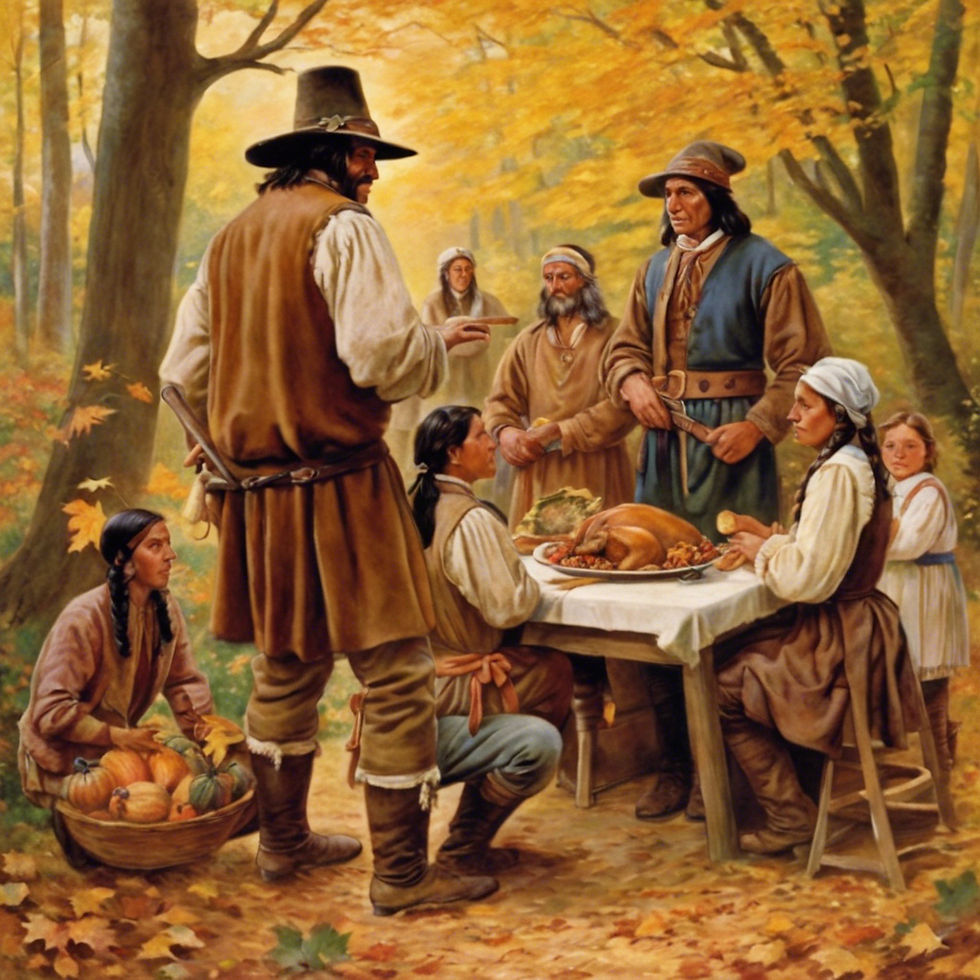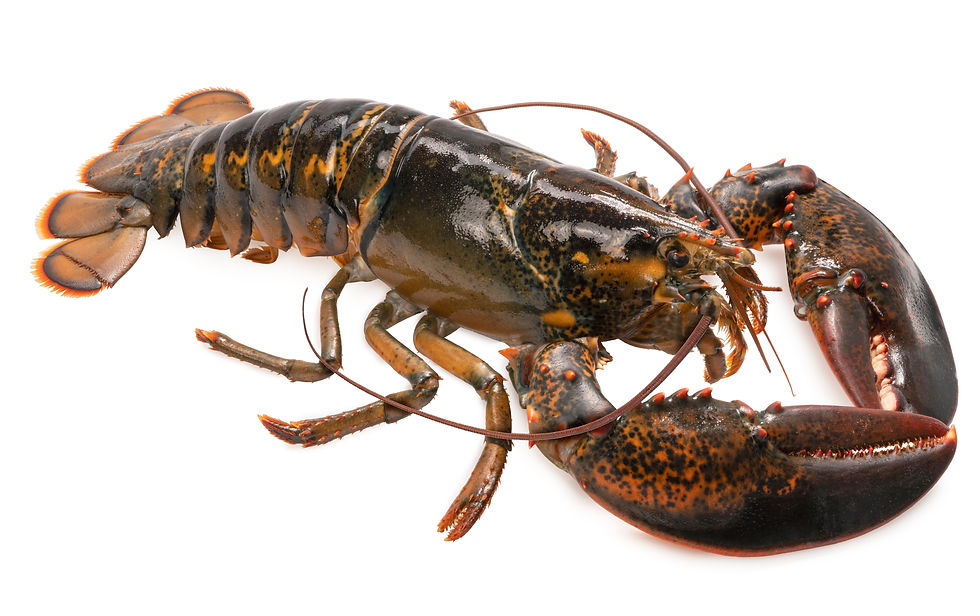Happy Thanksgiving 2024
- familytreearchaeol
- Nov 27, 2024
- 6 min read
Some interesting true historical facts you may not know about our American Thanksgiving
Every fourth Thursday of November Americans gather around tables laden with turkey, potatoes, cranberry sauce, sweet potato casserole, gravy, stuffing, or dressing (whatever your ancestors called it, my family and area of the country called it stuffing), pumpkin, pecan, and apple pies, or other delectable delights. Over the feast, many family and friends share what they are most thankful for from the previous year.

However, that has not always been the way Thanksgiving has been celebrated. The evolution of the holiday and its traditions have changed – from a much-mythologized 1621 harvest feast shared by the Pilgrims and the Wampanoag in the Plymouth colony to a post-Civil-War era patriotic and religious gatherings to the modern holiday focused on good food and spending time with family and friends.
It's kind of a convoluted journey.
The true history of how the first Thanksgiving came about:
In 1841 Boston publisher Alexander Young printed a book containing a letter by pilgrim Edward Winslow which described the feast:
“[O]ur harvest being gotten in, our governor sent four men on fowling, that we might after
more special manner rejoice together… [There were] many of the Indians coming among
us, and among the rest their greatest King Massasoit, with some ninety men, whom for
three days we entertained and feasted.”
Winslow didn’t describe the feast as “Thanksgiving,” which at the time was considered a period of prayerful fasting. But when Young published the letter, he dubbed the meal the “first Thanksgiving” in a footnote, and the name stuck.
Unfortunately, the reason for that feast was not a happy one --- and the relationship between the Pilgrims and the Wampanoag was fraught with trepidation. You see when the Pilgrims first arrived in 1620 at Plymouth Rock, they were woefully unprepared and had little food having consumed much of it on the voyage across the Atlantic, so they robbed corn from the Native Americans' storehouses.


In November 1621, the Wampanoag heard the pilgrims shooting off guns --- which historians believed that the Wampanoag thought a war was underway. King Massasoit sent 90 tribal members to investigate before realizing the Pilgrims were amid a celebration. The Wampanoag then hunted and harvested deer and joined the festivities.
Historians long considered the first Thanksgiving to have taken place in 1621, when the Mayflower Pilgrims, who founded the Plymouth Colony sat down for a three-day meal with the Wampanoag. But the meal wasn’t truly the meaningful symbol of peace that it was later portrayed to be, rather, it was likely just a routine English harvest celebration in 1621.
By 1623 there had been a newfound peace between the Pilgrims and Wampanoag that was largely driven by tribe and trade rivalries, according to Ann McMullen, curator of the National Museum of the American Indian, who said that the Wampanoag understood that an alliance with the Pilgrims could “fortify their strength.” Thence the celebration.
Food historian, Sarah Wassberg Johnson, said that peace did not last long. By 1637 the détente between the Pilgrims and the Wampanoag had disintegrated. The Pilgrims started a decades-long war with their indigenous neighbors. Ultimately, the colonists massacred the local tribes, including the Wampanoag in King Philip’s War. Incidentally, one of my ancestors, Daniel Goble, was hanged in the Boston Commons for his part in the massacre. Yikes, there’s a genealogical fact that one does not want to uncover in their family tree research! But then we all have those "black sheep" in our ancestral lineage somewhere.
Following along with the history I wrote about above, the first recorded Thanksgiving Day in Plymouth truthfully took place a full two years after the 1621 feast. It celebrated the end of a two-month drought in 1623. Later, Thanksgiving celebrations were held as military victories over Native Americans. Truly, recorded history sometimes takes a muddled path.
Turkey takes center stage:

Turkey is one of the Thanksgiving dishes that can easily be traced to the first Thanksgiving. The pilgrims and Native Americans in New England likely hunted and served wild fowl, like geese, duck, or turkey. The native, large bird was relatively easy to capture, so it quickly became an important source of food for early American settlers. Indeed, when I visit Martha’s Vineyard, a beautiful New England haven, turkeys are prolific, and I have seen one in particular that likes to visit the home in which I have stayed many times.
Turkeys have been kept as domesticated animals for over 2000 years by Indigenous people in Mesoamerica long before European contact. In the 1500s, Spanish traders brought some of the fowl that had been domesticated by indigenous Americans to Europe and Asia. The birds were first taken to Spain in about the year 1519, and from Spain they spread throughout Europe, reaching England in 1541. When the bird became popular in England, the name Turkey-cock, formerly used for the guinea fowl of Islamic (or Turkish) lands, was transferred to it.
It’s unclear if the turkey in 1623 was roasted on a spit, braised, or boiled in a large kettle at that harvest gathering. But, it is probable that the remains of whatever birds were roasted on one day, were thrown in a pot and boiled to make a broth for the next day, similar to gravy.

In addition to turkey as the main course, seafood, especially lobster and eel were likely part of the meal due to the colonists’ locale near the coast.
How the Thanksgiving menu has evolved:

It’s likely that the pilgrims prepared and ate stuffing at their early harvest feasts, as evidenced by old colonial cookbook recipes. Pilgrims called stuffing “puddings in the belly” and typically added herbs, hardened egg yolks, grated bread, cream, raisins or currants, sugar, spices, and nuts. However, the formerly traditional method of cooking the “stuffing” in the bird may not have been used because using a spit did not lead to even cooking, which makes sense even today as cooks are now urged to bake the “stuffing” or “dressing” separate from the turkey.
“Indian corn pudding” was also part of the meal (usually minus the sweetener) utilizing cornmeal from the copious crops of corn that the indigenous Americans grew.

Pumpkin pie, the most iconic of desserts for Thanksgiving, may have been an important staple for a celebration in New England colonial America. The Wampanoag introduced the Pilgrims to the venerated orange gourd. Most likely the Pilgrims ate boiled pumpkin with seasonings since the required flour for the crust, and the sugar and molasses for the custard were not readily available.

Because sugar or molasses was not readily available in 1623, other dishes that are commonplace at our present-day Thanksgiving dinner were non-existent or were prepared in a different manner, or for a different use, such as cranberry sauce. Since the cranberry grew wild in New England bogs it may have been mashed into sauces for the meats or added to stuffing.
Although these dishes are often associated with Thanksgiving emanated from regional New England, today we often add dishes to our feasts that are culturally popular to our particular ethnic backgrounds, such as macaroni and cheese, lasagna, tamales, spanakopita, and other common ethnic delicacies.
Presently, most people finish off the meal with a slice of pie, perhaps pumpkin, apple, sweet potato, or pecan pie (if you are in the southern United States). Just add a dollop of whipped cream and yum!!!
The importance of learning about the "first Thanksgiving":
It is important to know the origins of our American Thanksgiving to educate ourselves about the true history of the holiday which has been distorted and reshaped through the years along with cultural shifts in our society. I dare say that most of our children’s school textbooks have not portrayed the truth about Thanksgiving including the settling of Plymouth Plantation. But, that is another whole discussion for a later blog post.
More interesting, but more obscure facts, about Thanksgiving:

Originally thanksgiving days were usually declared by governors or religious figures. George Washington frequently declared days of thanksgiving during his tenure as general of the Continental Army and, once he became president, Washington proclaimed the first day of Thanksgiving in 1789.
However, many subsequent presidents chose to ignore the tradition until President Abraham Lincoln once again proclaimed it a holiday and established Thanksgiving Day as a national holiday during the Civil War thereby cementing the celebration as an American tradition. By doing so Lincoln hoped to help unite our nation that was living with such divisiveness due to the war. He was looking for a path to gloss over the schism created by the Civil War and to attempt to homogenize an American identity. Even so, the holiday was not celebrated universally in the

states --- particularly not in the Southern states that saw it as a “Yankee” holiday.
It may be difficult for us as present-day Americans to reconcile with that history because Thanksgiving has a kind of legendary mythology around it. Today most Americans no longer celebrate that myth, although our school history books tell us the contrary and continue to write about the first Thanksgiving and the Massachusetts Bay Colony in a bucolic manner. Today we are just celebrating family and friends, and proclaiming gratitude.

And finally, did you know that President John F. Kennedy was the first president to pardon a turkey creating the modern “turkey pardon tradition?" Although he didn’t officially “pardon” the turkey he spared one in 1963 setting the stage for the first “turkey pardon.”

So, I say, HAPPY THANKSGIVING to everyone no matter how or where you may celebrate the day. Enjoy your time with family and friends by partaking in a delicious feast.




Comments